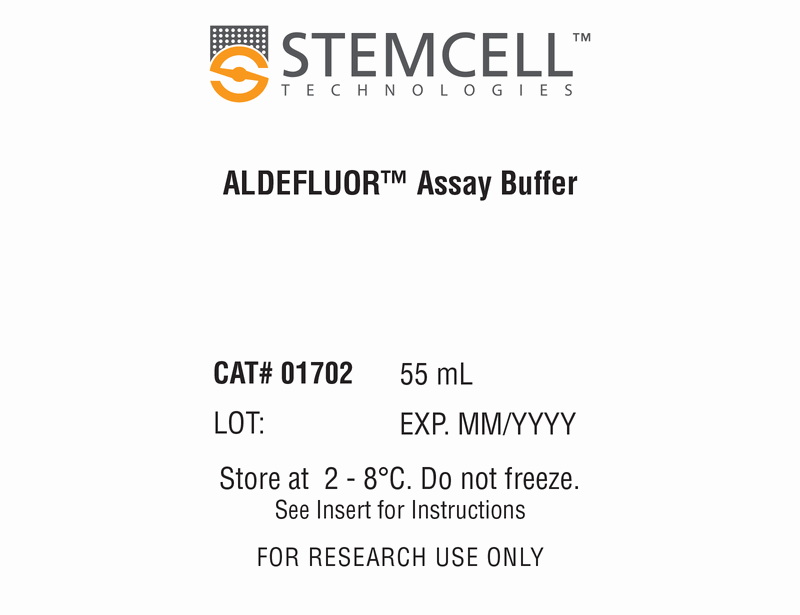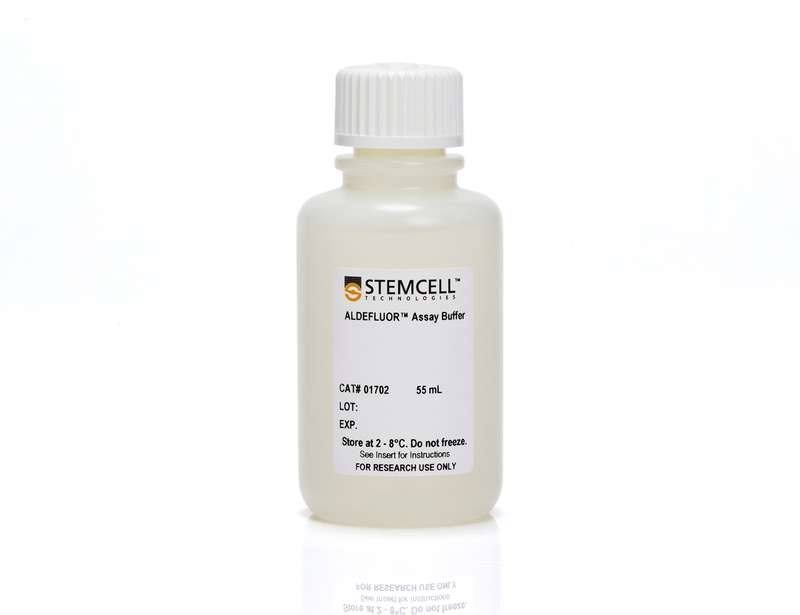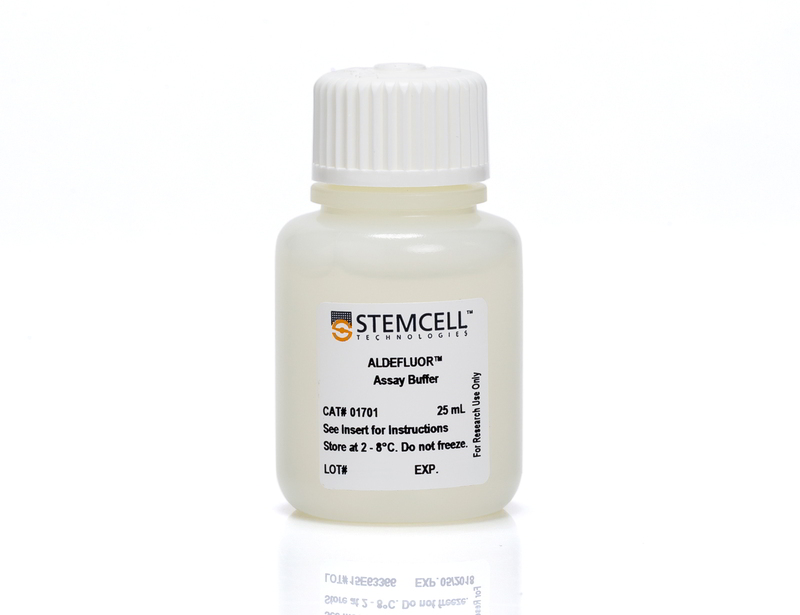ALDEFLUOR™ Assay Buffer
Assay buffer for labeling with the ALDEFLUOR™ kit
概要
ALDEFLUOR™ Assay Buffer can be used when counterstaining ALDEFLUOR™-reacted cells with immunofluorescently-labeled antibodies. The buffer is necessary to maintain ALDEFLUOR™ reaction product inside the cell, allowing detection of the ALDH-bright population. While there is sufficient ALDEFLUOR™-buffer contained within the ALDEFLUOR™ kit, additional buffer may be required for certain immunolabeling procedures.
Components
-
ALDEFLUOR™ Assay Buffer (Catalog #01701)
- ALDEFLUOR™ Assay Buffer, 25 mL
-
ALDEFLUOR™ Assay Buffer (Catalog #01702)
- ALDEFLUOR™ Assay Buffer, 55 mL
Species
Human, Mouse, Rat, Non-Human Primate, Other
Brand
ALDEFLUOR
Area of Interest
Cancer Research, Neuroscience, Stem Cell Biology
技术资料
| Document Type | 产品名称 | Catalog # | Lot # | 语言 |
|---|---|---|---|---|
| Product Information Sheet | ALDEFLUOR™ Assay Buffer | 01701 | All | English |
| Safety Data Sheet | ALDEFLUOR™ Assay Buffer | 01701, 01702 | All | English |
数据及文献
Publications (77)
International journal of cancer. Journal international du cancer 2012 JAN
Expression of aldehyde dehydrogenase and CD133 defines ovarian cancer stem cells.
Abstract
Abstract
Identification of cancer stem cells is crucial for advancing cancer biology and therapy. Several markers including CD24, CD44, CD117, CD133, the G subfamily of ATP-binding cassette transporters (ABCG), epithelial specific antigen (ESA) and aldehyde dehydrogenase (ALDH) are used to identify and investigate human epithelial cancer stem cells in the literature. We have now systemically analyzed and compared the expression of these markers in fresh ovarian epithelial carcinomas. Although the expression levels of these markers were unexpectedly variable and partially overlapping in fresh ovarian cancer cells from different donors, we reliably detected important levels of CD133 and ALDH in the majority of fresh ovarian cancer. Furthermore, most of these stem cell markers including CD133 and ALDH were gradually lost following in vitro passage of primary tumor cells. However, the expression of ALDH and CD133, but not CD24, CD44 and CD117, could be partially rescued by the in vitro serum-free and sphere cultures and by the in vivo passage in the immune-deficient xenografts. ALDH+ and CD133+ cells formed three-dimensional spheres more efficiently than their negative counterparts. These sphere-forming cells expressed high levels of stem cell core gene transcripts and could be expanded and form additional spheres in long-term culture. ALDH+ , CD133+ and ALDH+ CD133+ cells from fresh tumors developed larger tumors more rapidly than their negative counterparts. This property was preserved in the xenografted tumors. Altogether, the data suggest that ALDH+ and CD133+ cells are enriched with ovarian cancer-initiating (stem) cells and that ALDH and CD133 may be widely used as reliable markers to investigate ovarian cancer stem cell biology.
Journal of immunology (Baltimore, Md. : 1950) 2011 MAY
Hepatic stellate cells function as regulatory bystanders.
Abstract
Abstract
Regulatory T cells (Tregs) contribute significantly to the tolerogenic nature of the liver. The mechanisms, however, underlying liver-associated Treg induction are still elusive. We recently identified the vitamin A metabolite, retinoic acid (RA), as a key controller that promotes TGF-β-dependent Foxp3(+) Treg induction but inhibits TGF-β-driven Th17 differentiation. To investigate whether the RA producing hepatic stellate cells (HSC) are part of the liver tolerance mechanism, we investigated the ability of HSC to function as regulatory APC. Different from previous reports, we found that highly purified HSC did not express costimulatory molecules and only upregulated MHC class II after in vitro culture in the presence of exogenous IFN-γ. Consistent with an insufficient APC function, HSC failed to stimulate naive OT-II TCR transgenic CD4(+) T cells and only moderately stimulated α-galactosylceramide-primed invariant NKT cells. In contrast, HSC functioned as regulatory bystanders and promoted enhanced Foxp3 induction by OT-II TCR transgenic T cells primed by spleen dendritic cells, whereas they greatly inhibited the Th17 differentiation. Furthermore, the regulatory bystander capacity of the HSC was completely dependent on their ability to produce RA. Our data thus suggest that HSC can function as regulatory bystanders, and therefore, by promoting Tregs and suppressing Th17 differentiation, they might represent key players in the mechanism that drives liver-induced tolerance.
Cancer research 2011 MAR
Activation of the aryl hydrocarbon receptor AhR Promotes retinoic acid-induced differentiation of myeloblastic leukemia cells by restricting expression of the stem cell transcription factor Oct4.
Abstract
Abstract
Retinoic acid (RA) is used to treat leukemia and other cancers through its ability to promote cancer cell differentiation. Strategies to enhance the anticancer effects of RA could deepen and broaden its beneficial therapeutic applications. In this study, we describe a receptor cross-talk system that addresses this issue. RA effects are mediated by RAR/RXR receptors that we show are modified by interactions with the aryl hydrocarbon receptor (AhR), a protein functioning both as a transcription factor and a ligand-dependent adaptor in an ubiquitin ligase complex. RAR/RXR and AhR pathways cross-talk at the levels of ligand-receptor and also receptor-promoter interactions. Here, we assessed the role of AhR during RA-induced differentiation and a hypothesized convergence at Oct4, a transcription factor believed to maintain stem cell characteristics. RA upregulated AhR and downregulated Oct4 during differentiation of HL-60 promyelocytic leukemia cells. AhR overexpression in stable transfectants downregulated Oct4 and also decreased ALDH1 activity, another stem cell-associated factor, enhancing RA-induced differentiation as indicated by cell differentiation markers associated with early (CD38 and CD11b) and late (neutrophilic respiratory burst) responses. AhR overexpression also increased levels of activated Raf1, which is known to help propel RA-induced differentiation. RNA interference-mediated knockdown of Oct4 enhanced RA-induced differentiation and G(0) cell-cycle arrest relative to parental cells. Consistent with the hypothesized importance of Oct4 downregulation for differentiation, parental cells rendered resistant to RA by biweekly high RA exposure displayed elevated Oct4 levels that failed to be downregulated. Together, our results suggested that therapeutic effects of RA-induced leukemia differentiation depend on AhR and its ability to downregulate the stem cell factor Oct4.
Journal of cellular and molecular medicine 2011 JAN
Aldehyde dehydrogenase activity promotes survival of human muscle precursor cells.
Abstract
Abstract
Aldehyde dehydrogenases (ALDH) are a family of enzymes that efficiently detoxify aldehydic products generated by reactive oxygen species and might therefore participate in cell survival. Because ALDH activity has been used to identify normal and malignant cells with stem cell properties, we asked whether human myogenic precursor cells (myoblasts) could be identified and isolated based on their levels of ALDH activity. Human muscle explant-derived cells were incubated with ALDEFLUOR, a fluorescent substrate for ALDH, and we determined by flow cytometry the level of enzyme activity. We found that ALDH activity positively correlated with the myoblast-CD56(+) fraction in those cells, but, we also observed heterogeneity of ALDH activity levels within CD56-purified myoblasts. Using lentiviral mediated expression of shRNA we demonstrated that ALDH activity was associated with expression of Aldh1a1 protein. Surprisingly, ALDH activity and Aldh1a1 expression levels were very low in mouse, rat, rabbit and non-human primate myoblasts. Using different approaches, from pharmacological inhibition of ALDH activity by diethylaminobenzaldehyde, an inhibitor of class I ALDH, to cell fractionation by flow cytometry using the ALDEFLUOR assay, we characterized human myoblasts expressing low or high levels of ALDH. We correlated high ALDH activity ex vivo to resistance to hydrogen peroxide (H(2) O(2) )-induced cytotoxic effect and in vivo to improved cell viability when human myoblasts were transplanted into host muscle of immune deficient scid mice. Therefore detection of ALDH activity, as a purification strategy, could allow non-toxic and efficient isolation of a fraction of human myoblasts resistant to cytotoxic damage.
Oncogene 2011 JAN
The lymphovascular embolus of inflammatory breast cancer exhibits a Notch 3 addiction.
Abstract
Abstract
Inflammatory breast carcinoma (IBC) is characterized by exaggerated lymphovascular invasion (LVI), recapitulated in our human xenograft, MARY-X. This model exhibited lymphovascular emboli in vivo and corresponding spheroids in vitro. Owing to the morphological and gene profile resemblance of these spheroids to embryonal blastocysts, we wondered whether they might exhibit embryonic stem cell signaling. Specifically we investigated Notch and observed selective Notch 3 activation by expression profiling, reverse transcriptase- and real-time PCR, western blot and immunofluorescence in vitro, and immunohistochemistry in vivo. Notch 3 intracellular domain (N3icd) and six target genes, HES-5, HEY-1, c-Myc, Deltex-1, NRARP and PBX1, markedly increased in MARY-X. In addition, a significant percentage of MARY-X cells expressed aldehyde dehydrogenase (ALDH), a stem cell marker. Only the ALDH(+) cells were capable of secondary spheroidgenesis, tumorigenicity and self-renewal. Inhibiting Notch 3 activation in vitro with γ-secretase inhibitors (GSIs) or small interfering RNA resulted in a downregulation of Notch target genes, including CD133, and an induction of caspase 3-mediated apoptosis. Transfection of N3icd but not Notch 1 intracellular domain into normal human mammary epithelial cells resulted in increased expression of Notch target genes and induction of spheroidgenesis. GSI in vivo resulted in inhibitory but diffusion-limited effects on Notch 3 signaling, resulting in xenograft growth reduction. The lymphovascular emboli of human IBC exhibited dual N3icd and ALDH1 immunoreactivities independently of molecular subtype. This Notch 3 addiction of lymphovascular emboli might be exploited in future therapeutic strategies.
Biochemical and biophysical research communications 2011 FEB
Aldehyde dehydrogenase 1B1 (ALDH1B1) is a potential biomarker for human colon cancer.
Abstract
Abstract
Aldehyde dehydrogenases (ALDHs) belong to a superfamily of NAD(P)+-dependent enzymes, which catalyze the oxidation of endogenous and exogenous aldehydes to their corresponding acids. Increased expression and/or activity of ALDHs, particularly ALDH1A1, have been reported to occur in human cancers. It is proposed that the metabolic function of ALDH1A1 confers the stemness" properties to normal and cancer stem cells. Nevertheless�



